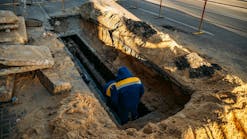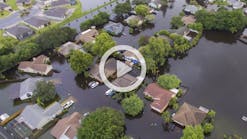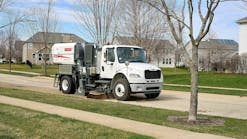Keeping a city’s streets, storm sewers, and catch basins clean is an essential service for its residents, even though they might not pay much attention to the work as it occurs. Cleaner air and water are the result—proven by numerous studies—and that’s important to every person within a community.
San Diego, CA, has 75,000 storm drains and 889 miles of drainage pipe to keep clean. Concrete and dirt storm drain channels total 84 miles, surrounded by more than 100 miles of fencing (to keep people and debris out).
In San Diego, a crew of 16 works hard to keep the city’s 2,700 miles of improved streets clean. That many miles of streets add up to a lot of sweeping.
Keeping a city’s streets, storm sewers, and catch basins clean is an essential service for its residents, even though they might not pay much attention to the work as it occurs. Cleaner air and water are the result—proven by numerous studies—and that’s important to every person within a community. San Diego, CA, has 75,000 storm drains and 889 miles of drainage pipe to keep clean. Concrete and dirt storm drain channels total 84 miles, surrounded by more than 100 miles of fencing (to keep people and debris out). In San Diego, a crew of 16 works hard to keep the city’s 2,700 miles of improved streets clean. That many miles of streets add up to a lot of sweeping. [text_ad] “We’re averaging about 100,000 miles swept in a year,” says Thomas Abeyta III, public works supervisor for the San Diego Storm Water Department. That sweeping keeps 220,000 pounds of debris out of the storm drains. The city’s street sweeping crewmembers drive a fleet of 17 sweepers, including five regenerative-air type and one vacuum sweeper. The rest are the mechanical type. None of the sweepers operates on alternative fuels. “We had a managed competition three years ago and minimized our fleet, to cut costs,” says Abeyta. “We’ll add some sweepers back.” Abeyta prefers to keep “a diverse fleet,” with sweepers from different manufacturers. “We’ve done some studies on which ones are most effective for our terrain,” he explains (“Street Sweeping Pilot Studies,” January/February 2013, Stormwater). However, the San Diego crews rely on regenerative air sweepers from Tymco. Their chosen Tymco model is the 500x. Abeyta likes the Tymco 500x sweepers “for their stormwater quality aspects. They keep everything inside the hopper and they have separators. We find they’re more effective in capturing fine particles.” He adds, “From a maintenance standpoint, there are fewer moving parts so the cost to maintain and repair them is less.” The Tymco 500x combines advanced electronics and the industry’s highest dumping hopper lift assembly—a whopping 11 feet. This sweeper’s fast dump cycle is less than 68 seconds. San Diego’s street sweeping crews operate on two shifts. The daytime crews sweep residential areas, either once a month or once every other month depending on whether the areas are categorized as high- or low-maintenance need. The night crews clean streets in the commercial districts and highly traveled roads. These areas are swept once a week. The crews pay particular attention to streets in sensitive water-quality areas such as La Jolla, Chollas Creek, and Los Pinasquitos. If necessary, they sweep these areas more frequently. Regular street sweeping and catch basin cleaning schedules are suspended before, during, and after heavy rainstorms. At these times the employees in the various divisions of the Public Works Department operate under “storm patrol mode.” “They’re all assigned to certain areas of the city. They check to be sure that critical drains are working to prevent flooding, clean right of ways, and remove tree debris or mud,” says Abeyta.“We’re averaging about 100,000 miles swept in a year,” says Thomas Abeyta III, public works supervisor for the San Diego Storm Water Department. That sweeping keeps 220,000 pounds of debris out of the storm drains.
The city’s street sweeping crewmembers drive a fleet of 17 sweepers, including five regenerative-air type and one vacuum sweeper. The rest are the mechanical type. None of the sweepers operates on alternative fuels.
“We had a managed competition three years ago and minimized our fleet, to cut costs,” says Abeyta. “We’ll add some sweepers back.”
Abeyta prefers to keep “a diverse fleet,” with sweepers from different manufacturers. “We’ve done some studies on which ones are most effective for our terrain,” he explains (“Street Sweeping Pilot Studies,” January/February 2013, Stormwater).
However, the San Diego crews rely on regenerative air sweepers from Tymco. Their chosen Tymco model is the 500x. Abeyta likes the Tymco 500x sweepers “for their stormwater quality aspects. They keep everything inside the hopper and they have separators. We find they’re more effective in capturing fine particles.”
He adds, “From a maintenance standpoint, there are fewer moving parts so the cost to maintain and repair them is less.”
The Tymco 500x combines advanced electronics and the industry’s highest dumping hopper lift assembly—a whopping 11 feet. This sweeper’s fast dump cycle is less than 68 seconds.
San Diego’s street sweeping crews operate on two shifts. The daytime crews sweep residential areas, either once a month or once every other month depending on whether the areas are categorized as high- or low-maintenance need. The night crews clean streets in the commercial districts and highly traveled roads. These areas are swept once a week.
The crews pay particular attention to streets in sensitive water-quality areas such as La Jolla, Chollas Creek, and Los Pinasquitos. If necessary, they sweep these areas more frequently.
Regular street sweeping and catch basin cleaning schedules are suspended before, during, and after heavy rainstorms. At these times the employees in the various divisions of the Public Works Department operate under “storm patrol mode.”
“They’re all assigned to certain areas of the city. They check to be sure that critical drains are working to prevent flooding, clean right of ways, and remove tree debris or mud,” says Abeyta.
One might think that in a city that doesn’t have to deal with long snow or rain seasons, keeping the streets swept would be relatively easy. But every city has its own challenges when it comes to street sweeping.
“Parked cars,” says Abeyta. “People don’t understand the impact of street sweeping. Some areas are so densely populated that they don’t have off-street parking, so we balance between posting areas for sweeping [temporarily no parking allowed] and keeping these people happy.”
As is the case in most cities and regions, vegetation makes extra work for San Diego’s street sweeping crews. The organic debris varies by season.
“In the fall, we have a lot of leaves from trees in certain areas. In the summer, pine needles are one of our problems,” he says.
The heavier winds associated with storms, such as the hot Santa Ana winds, strew small branches and eucalyptus pods all over the streets. And in beach areas of San Diego, palm fronds fall off of palm trees, littering the streets.
“We operate on a five-year contract, and our budget increases every year,” explains Abeyta. “We’re in year three now, and the budget for street sweeping is $3 million for the year.”
San Diego has done some studies on how street sweeping influences the amount of pollution in stormwater runoff and continues to do so.
“We’re in our fifth study now,” says Abeyta. “They tested for a whole year during dry weather the material we picked up, and they monitored storm drains. They tested storm drains both before and after we swept.”






